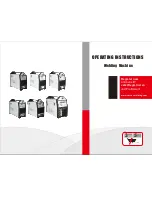
WPM System
USER GUIDE
WPM
User Guide v1.0
Page 34
Flown Systems
WPM’s rigging has been derived from the highly successful rigging system employed on the MLA Mini Multicellular system. This
has proved to be popular, quick and above all safe. Rigging WPM will be instantly familiar to anyone who has rigged Martin
Audio systems in the past, we have made a few minor improvements to make it even easier to use and it has proved to be
incredibly quick to fly and land.
WPM uses a three-point rigging system. The mechanical load of the array is taken through the side-mounted steel rigging strips
which securely connect one cabinet to the next, while the best possible coupling between cabinets is ensured by means of the
rear rigging points which allow a range of angle adjustment from 0.5° to 10°.
Fig.1 - push central button
Fig.2 - remove rigging pin
Fig.3 - replace rigging pin
The cabinets are joined using machined quick release Rigging Pins. These have spring loaded ball bearings at the end of
the pin which protrude beyond the outer diameter of the pin thus locking them in place. To release them, the central button is
depressed (fig. 1) whilst pulling the pin clear using the wide flange (fig. 2). This is best done with the fore and index fingers
pulling the pin whilst your thumb depresses the central button, a very quick and easy operation. When using the pins to link
cabinets, the central button must again be depressed so the pin can be pushed into position (fig. 3). It is important to check
that the central button does not remain depressed once you have put it in place as this would indicate that the pin has not been
pushed all the way into position and the ball bearings at the end of the pin have not been able to pop out and lock the pin in
place. If the pin is not locked the array is unsafe. The pin MUST be repositioned until it is securely locked in place.
Fig 4 - drop link down
Fig.5 - drop link up
Inter-cabinet angles are set using the rear rigging assembly. This consists of a sliding drop link bar with indexed holes which can
be slid vertically downwards between the two constraining steel brackets, and secured with the Rigging Pins in one of several
different positions determined by the holes in the rear bracket assembly, allowing inter-cabinet angle adjustment in five
incremental steps of 0.5°, 2°, 4°, 6.5°, and 10°.
















































